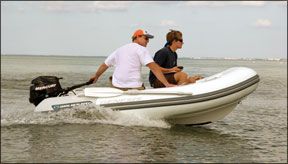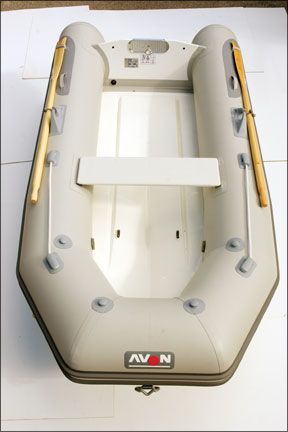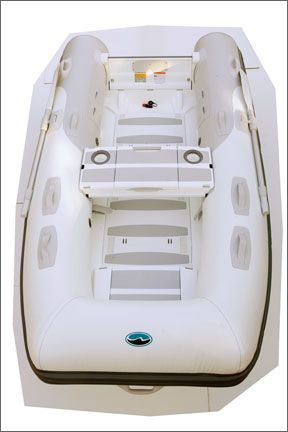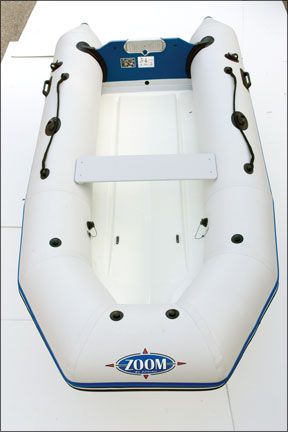In a follow-up to last months review of fixed-transom rigid inflatable boats, Practical Sailor looked at three 10-foot, folding-transom dinghies: the Walker Bay Genesis 310 FTD, Avon Rover 310 Lite, and the Zodiac Zoom 310SR. These three have the advantage of being easily stowed on deck, without taking up as much space as their fixed-transom counterparts. We tested each RIB dinghy for top speed, planing speed, overall performance at high and low speeds, spray deflection, and rowing. We looked at design, quality of construction, details, extras, price, and warranty-with an emphasis on price and warranty versus construction materials. PVC inflatable dinghies are not as durable as those made of Hypalon and generally carry a shorter warranty, but they are less expensive and can meet the needs of those in more temperate climates.
****

Practical Sailor corralled 11 lightweight rigid inflatable boats (RIBs) in the 10-foot range from seven manufacturers. We separated them into two groups-boats with rigid or fixed transoms and those with folding transoms.
In the July 2008 issue, we introduced eight rigid-transom boats, with the Achilles HB315-LX earning Practical Sailors Best Choice title. The transoms and decks of those RIBs had the strength and stiffness needed to withstand the weight and thrust of four-stroke engines with 10 horsepower or more. The transoms also provided sturdy attachment points for eyebolts for lifting and lowering the boats on davits. But-and theres always a “but” when talking about boat design-many of these boats were too heavy to easily launch and stow on deck. Even with the help of a halyard, a dinghy weighing more than 120 pounds makes deck stowage a back-straining chore for a two-member crew.
The fixed-transom boats we tested averaged 132 pounds, while two of the three folding-transom models we review here weigh just over 90 pounds. The third foldable-transom RIB tested is something of an anomaly, and actually compares favorably with those in our fixed-transom test. The two-piece transom on the Walker Bay Genesis 310 FTD (Folding Transom Deluxe) stands sturdily when assembled but also folds forward for storage. Heres the “but”: The boat weighs in at 135 pounds.
How much space can be saved with a folding-transom boat? About 6 inches in height. It doesn’t seem like much, but its enough to allow the necessary clearance for a boom, jib, or staysail on some boats.
What We Tested
For this review, we tested the Walker Bay Genesis 310 FTD, Avon Rover 310 Lite, and the Zodiac Zoom 310SR. All measure 10 feet, 2 inches in length. At 5 feet, 5 inches wide, the Walker Bay is the beamiest and offers the most interior volume. The Zodiac is the narrowest, with a beam of 4 feet, 11 inches, and has the least inside room.
Pricing differs substantially: The Avon comes in at $3,300, the Zodiac Zoom $2,000, and the Walker Bay $3,900. All three boats come with zippered storage bags.
In the all-important weight category, the Avon (94 pounds) and the Zodiac (92 pounds) legitimately fall into the lightweight RIB category. The Walker Bay, however, does not. Its more than 40 pounds heavier. The test field includes two Hypalon RIBs and one PVC boat. (See “Hypalon vs. PVC,” above.) Its less expensive to manufacture a RIB with PVC; this is evidenced by the Zodiacs lower price. The PVC boat has a five-year warranty, while both the Walker Bay and Avon are backed by 10 years of factory protection.
All three boats are designed to carry four people. The heavier Walker Bay can handle more horsepower-the manufacturer recommends 10 horsepower, compared to 8 horses for the other two dinghies.
Avon Rover 310 Lite
Like its rigid-transom sibling, the Rover 315, Rover 310 Lite is also the most expensive among its test group, with a price tag of nearly $3,000. Injection molding keeps the hull light and strong. Practical Sailor testers liked the pivoting carrying handle at the bow. The Hypalon straps on the top of the tubes aft could be larger and padded,

like on the Walker Bay, in our opinion. The boat has a secure means of holding the oars on top of the tubes. Hypalon Straps hold the paddles, and elastic hooks secure the handle ends of the oars.
Nonskid covers the deck, which is flat aft and V-shaped from amidships forward. Four raised buttons fanned around the bow of our test boat are attachment points for an optional dodger. The boat had only one lifting ring-on the forward portion of the deck.
The drain plug was in the starboard corner instead of on centerline. And it is raised a good inch above the deck.
The rubrail is as thick as they come. Keeping with the light-is-right theme, this boat lacks forward storage. The aft section of the hull bottom is flatter than the Rover.
The Avon could be maneuvered easily at low speeds and in reverse. It also jumped up on plane quickly-6 seconds. The 310 was pretty fast, hitting 20.5 mph at full blast-3 mph faster than the Walker Bay. On the downside, the Avon skidded noticeably in high-speed cornering, and our testers reported that it was “very bouncy” during its sea trial.
The boats molded oar locks failed to hold the oars very well. Testers managed to pop the oars out of the locks several times during their rowing exercise.
Bottom line: The Rover 310 Lites strengths are its light weight, speed, and 10-year warranty. If a folding transom and light weight are your priorities, this is a good pick. It earns a Practical Sailor Recommended rating.
Walker Bay Genesis 310 FTD
Practical Sailor gave a thumbs-up to Walker Bays smaller 270 Genesis FTD in the December 2007 issue, so testers expected much of its big brother. The manufacturer has lined the aft portions of each tube with three padded handholds, which are quite comfortable on the hands. There are also three robust, hard-rubber carrying handles-one on the bow and one on top of each tube all the way aft.
The two aft lifting rings are bolted through the transom instead of secured to the deck, so you wont be stubbing your toes. The bow ring is attached to the deck, but out of the way.
The boat comes with only one towing eye, rather than the standard pair. However,

Walker Bay claims the deep-V hull enables the boat to track straight when towed by the single point. The boats nonskid-covered interlocking deck and center seat can be removed, shedding about 40 pounds from the total weight. The job takes some practice, but the pieces can be assembled and disassembled with relative ease. Unlike the other boats (including the featured rigid-transom models), the Walker Bays bench seat includes storage space. It also has a removable tray, two cupholders, and an aft grabrail.
Other extras include bow seat and forward storage compartments. The seat is wider than the other boats, too-about 14 inches, compared to about 10 inches for those on the other boats.
The drain hole is 1 inch in diameter, which is pretty big compared to those on the competitions craft. The plug has a locking lever, and our test boat had a lanyard to keep it on board. The rubrail is beefy, but it does not extend to cover the aft portions of the tubes.
Clocking 17.5 mph, the Walker Bay was not the fastest in the test fleet, but it was the most stable and delivered the smoothest ride. Testers reported excellent control at both high and low speeds. The Walker Bays mini trim tabs are meant, in part, to help the boat reach plane quickly, but our test boat took its time to get onto plane-11 seconds. This would likely be improved with the maximum 15-horsepower outboard. We tested with a 9.9-horsepower.
Bottom line: The Walker Bay delivers a solid, stable ride. Many of its features-additional storage space and plenty of handholds-compare more closely to some of the fixed-transom models in this size range. The warranty is good, too. However, theres no joy in manhandling 130-plus pounds onto the deck of a sailboat. At the opposite end of the spectrum from the Avon, the Walker Bay earns a Recommended rating for those who value ride over light weight.
Zodiac Zoom 310 SR
The Zodiac is the smallest, lightest, and least expensive in our group. It also takes up the least amount of space when stowed.
The only PVC boat in this trio, the 310 SR lacks forward handrails or grablines. It does have lines on the aft portions of the tube tops, so the driver-unlike the passenger at the bow-has something to hold. The manufacturer provides two hard-plastic carrying handles on the aft portions of the tube tops and one at the bow just below the rubrail. In the testers opinions, the bow handle needs more meat.
Two gutters are molded into the raised nonskid deck for drainage. The nonskid provides effective traction. The lifting ring at the bow is a potential toe-stubber.

The test boat had no lifting rings at the stern and a relatively thin rub rail.
Testers liked the oar and lock design, which allowed the oars to be feathered. The drain plug, attached by lanyard, inserts from outside the hull.
With the drivers weight adjusted slightly forward, the Zodiac hopped on top of the water in 5 seconds. Maneuverability at low speeds was flawless, but at high speeds, the Zodiac was the testers least favorite in terms of ride comfort, cornering, and handling.
At full throttle, the Zoom certainly lived up to its name. It was the fastest boat tested, reaching an eye-watering 22.5 mph. Prudence demands a light hand on the throttle when theres just one person in this boat.
The oars have large paddles, but testers said the oarlocks flexed too much to get a good bite.
Bottom line: The boat is light and pricing is attractive, but too many downsides-bumpy ride, no forward handholds, anemic rubrail-bump it back to third in this category.
Conclusion
The Walker Bay Genesis 310 FTD offers the most for the money, but its heavy. The extra weight is a concern, but the boats other strengths-ride quality, handholds, storage, Hypalon construction-cannot be overlooked. Its a Recommended choice among these three boats and the fixed-transom dinghies this size.
We like the Avon Rover 310 Lites light weight and warranty. Even though it didnt excel in terms of performance and features, the boat is a good choice for those looking at folding-transom dinghies.
The Zodiac Zoom, with its lower price, is a good candidate as a mooring tender for the budget-oriented sailor in a temperate climate. But if you want a full-time, far-ranging battle wagon, its worth paying more for the Avon or Walker Bay.
Practical Sailor corralled 11 lightweight rigid inflatable boats (RIBs) in the 10-foot range from seven manufacturers. We separated them into two groups-boats with rigid or fixed transoms and those with folding transoms.
In the July 2008 issue, we introduced eight rigid-transom boats, with the Achilles HB315-LX earning Practical Sailors Best Choice title. The transoms and decks of those RIBs had the strength and stiffness needed to withstand the weight and thrust of four-stroke engines with 10 horsepower or more. The transoms also provided sturdy attachment points for eyebolts for lifting and lowering the boats on davits. But-and theres always a “but” when talking about boat design-many of these boats were too heavy to easily launch and stow on deck. Even with the help of a halyard, a dinghy weighing more than 120 pounds makes deck stowage a back-straining chore for a two-member crew.
The fixed-transom boats we tested averaged 132 pounds, while two of the three folding-transom models we review here weigh just over 90 pounds. The third foldable-transom RIB tested is something of an anomaly, and actually compares favorably with those in our fixed-transom test. The two-piece transom on the Walker Bay Genesis 310 FTD (Folding Transom Deluxe) stands sturdily when assembled but also folds forward for storage. Heres the “but”: The boat weighs in at 135 pounds.
How much space can be saved with a folding-transom boat? About 6 inches in height. It doesn’t seem like much, but its enough to allow the necessary clearance for a boom, jib, or staysail on some boats.
What We Tested
For this review, we tested the Walker Bay Genesis 310 FTD, Avon Rover 310 Lite, and the Zodiac Zoom 310SR. All measure 10 feet, 2 inches in length. At 5 feet, 5 inches wide, the Walker Bay is the beamiest and offers the most interior volume. The Zodiac is the narrowest, with a beam of 4 feet, 11 inches, and has the least inside room.
Pricing differs substantially: The Avon comes in at $3,300, the Zodiac Zoom $2,000, and the Walker Bay $3,900. All three boats come with zippered storage bags.
In the all-important weight category, the Avon (94 pounds) and the Zodiac (92 pounds) legitimately fall into the lightweight RIB category. The Walker Bay, however, does not. Its more than 40 pounds heavier. The test field includes two Hypalon RIBs and one PVC boat. (See “Hypalon vs. PVC,” above.) Its less expensive to manufacture a RIB with PVC; this is evidenced by the Zodiacs lower price. The PVC boat has a five-year warranty, while both the Walker Bay and Avon are backed by 10 years of factory protection.
All three boats are designed to carry four people. The heavier Walker Bay can handle more horsepower-the manufacturer recommends 10 horsepower, compared to 8 horses for the other two dinghies.
Avon Rover 310 Lite
Like its rigid-transom sibling, the Rover 315, Rover 310 Lite is also the most expensive among its test group, with a price tag of nearly $3,000. Injection molding keeps the hull light and strong. Practical Sailor testers liked the pivoting carrying handle at the bow. The Hypalon straps on the top of the tubes aft could be larger and padded, like on the Walker Bay, in our opinion. The boat has a secure means of holding the oars on top of the tubes. Hypalon Straps hold the paddles, and elastic hooks secure the handle ends of the oars.
Nonskid covers the deck, which is flat aft and V-shaped from amidships forward. Four raised buttons fanned around the bow of our test boat are attachment points for an optional dodger. The boat had only one lifting ring-on the forward portion of the deck.
The drain plug was in the starboard corner instead of on centerline. And it is raised a good inch above the deck.
The rubrail is as thick as they come. Keeping with the light-is-right theme, this boat lacks forward storage. The aft section of the hull bottom is flatter than the Rover.
The Avon could be maneuvered easily at low speeds and in reverse. It also jumped up on plane quickly-6 seconds. The 310 was pretty fast, hitting 20.5 mph at full blast-3 mph faster than the Walker Bay. On the downside, the Avon skidded noticeably in high-speed cornering, and our testers reported that it was “very bouncy” during its sea trial.
The boats molded oar locks failed to hold the oars very well. Testers managed to pop the oars out of the locks several times during their rowing exercise.
Bottom line: The Rover 310 Lites strengths are its light weight, speed, and 10-year warranty. If a folding transom and light weight are your priorities, this is a good pick. It earns a Practical Sailor Recommended rating.
Walker Bay Genesis 310 FTD
Practical Sailor gave a thumbs-up to Walker Bays smaller 270 Genesis FTD in the December 2007 issue, so testers expected much of its big brother. The manufacturer has lined the aft portions of each tube with three padded handholds, which are quite comfortable on the hands. There are also three robust, hard-rubber carrying handles-one on the bow and one on top of each tube all the way aft.
The two aft lifting rings are bolted through the transom instead of secured to the deck, so you wont be stubbing your toes. The bow ring is attached to the deck, but out of the way.
The boat comes with only one towing eye, rather than the standard pair. However, Walker Bay claims the deep-V hull enables the boat to track straight when towed by the single point. The boats nonskid-covered interlocking deck and center seat can be removed, shedding about 40 pounds from the total weight. The job takes some practice, but the pieces can be assembled and disassembled with relative ease. Unlike the other boats (including the featured rigid-transom models), the Walker Bays bench seat includes storage space. It also has a removable tray, two cupholders, and an aft grabrail.
Other extras include bow seat and forward storage compartments. The seat is wider than the other boats, too-about 14 inches, compared to about 10 inches for those on the other boats.
The drain hole is 1 inch in diameter, which is pretty big compared to those on the competitions craft. The plug has a locking lever, and our test boat had a lanyard to keep it on board. The rubrail is beefy, but it does not extend to cover the aft portions of the tubes.
Clocking 17.5 mph, the Walker Bay was not the fastest in the test fleet, but it was the most stable and delivered the smoothest ride. Testers reported excellent control at both high and low speeds. The Walker Bays mini trim tabs are meant, in part, to help the boat reach plane quickly, but our test boat took its time to get onto plane-11 seconds. This would likely be improved with the maximum 15-horsepower outboard. We tested with a 9.9-horsepower.
Bottom line: The Walker Bay delivers a solid, stable ride. Many of its features-additional storage space and plenty of handholds-compare more closely to some of the fixed-transom models in this size range. The warranty is good, too. However, theres no joy in manhandling 130-plus pounds onto the deck of a sailboat. At the opposite end of the spectrum from the Avon, the Walker Bay earns a Recommended rating for those who value ride over light weight.
Zodiac Zoom 310 SR
The Zodiac is the smallest, lightest, and least expensive in our group. It also takes up the least amount of space when stowed.
The only PVC boat in this trio, the 310 SR lacks forward handrails or grablines. It does have lines on the aft portions of the tube tops, so the driver-unlike the passenger at the bow-has something to hold. The manufacturer provides two hard-plastic carrying handles on the aft portions of the tube tops and one at the bow just below the rubrail. In the testers opinions, the bow handle needs more meat.
Two gutters are molded into the raised nonskid deck for drainage. The nonskid provides effective traction. The lifting ring at the bow is a potential toe-stubber. The test boat had no lifting rings at the stern and a relatively thin rub rail.
Testers liked the oar and lock design, which allowed the oars to be feathered. The drain plug, attached by lanyard, inserts from outside the hull.
With the drivers weight adjusted slightly forward, the Zodiac hopped on top of the water in 5 seconds. Maneuverability at low speeds was flawless, but at high speeds, the Zodiac was the testers least favorite in terms of ride comfort, cornering, and handling.
At full throttle, the Zoom certainly lived up to its name. It was the fastest boat tested, reaching an eye-watering 22.5 mph. Prudence demands a light hand on the throttle when theres just one person in this boat.
The oars have large paddles, but testers said the oarlocks flexed too much to get a good bite.
Bottom line: The boat is light and pricing is attractive, but too many downsides-bumpy ride, no forward handholds, anemic rubrail-bump it back to third in this category.
Conclusion
The Walker Bay Genesis 310 FTD offers the most for the money, but its heavy. The extra weight is a concern, but the boats other strengths-ride quality, handholds, storage, Hypalon construction-cannot be overlooked. Its a Recommended choice among these three boats and the fixed-transom dinghies this size.
We like the Avon Rover 310 Lites light weight and warranty. Even though it didnt excel in terms of performance and features, the boat is a good choice for those looking at folding-transom dinghies.
The Zodiac Zoom, with its lower price, is a good candidate as a mooring tender for the budget-oriented sailor in a temperate climate. But if you want a full-time, far-ranging battle wagon, its worth paying more for the Avon or Walker Bay.





































Hello, just subcribed and looking for our first RIB(10’ish)(2 stroke?)or , not for hauling or stowing but just cannal crusing and ICW short island hops and exploring in Corpus area.(will be lifted with small lift (dock or bulkhead) tiller/basic/utilitairian. So most important is build/no nosense. Mil-spec/commerical , like ordering a work pick up with heavy axles minus the leather/dual climet controls. Thanks for any information. Rob Woolley